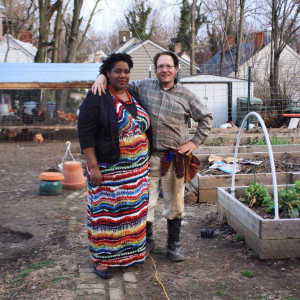The Amos Farm: Intensive Gardening
by Christian Torp
Consider the wastes incidental to the crowding into cities, made necessary by competition and by monopoly railroad-rates; consider the slums, the bad air, the disease and the waste of vital energies; consider the office- buildings, the waste of time and material in the piling of story upon story, and the burrowing underground! Then take the whole business of insurance, the enormous mass of administrative and clerical labor it involves, and all utter waste ”
-Upton Sinclair “The Jungle” 1906
Thankfully your garden will not languish nor grow diseased on account of your decision not to premise cultivation on the 36” rows common to commercial producers. It’s all about intensive gardening.
As I indicated in the first installment of The Amos Farm, “Garden plots can be up to 15 times more productive than rural holdings. An area of just one square meter can provide 20 kg of food a year.” (The Amos Farm: Everything Urban Farming, WEN November 5, 2015).
Let’s concentrate on ways to efficiently grow food in an urban environment where space is at a premium.
Wide Row Planting: Vegetables are grown in wide rows between narrow pathways, and multiple vegetable plants are grown beside each other within each row. Plants are spaced at equal distances from each other on all sides so that their leaves will just touch at maturity. In addition to saving space this also reduces moisture loss and reduces weeding. It’s typical agricultural spacing in reverse, instead of one row of crops every 36” you have a path every 36” of crop.
Raised Beds: A basic unit of intensive gardening, it enables you to concentrate soil preparation into small, discrete areas while minimizing soil compaction, erosion and run off. Because of it’s intensive nature, soil preparation is key to successful urban farming (See the January and February 2016 installments of The Amos Farm, “Composting” Parts I and II). A raised bed is by definition a form of Wide Row Planting.
Intercropping: The planting of different vegetables side by side within the same row so as to take advantage of plants’ differing times of maturity, height, spread, rooting depth and solar requirements.
A classic example of intercropping is the Three Sisters planting practiced by the Iroquois People in which corn, beans and squash were all planted together in the same field. The corn provided a pole for the beans to climb, the beans improved the soil by fixing nitrogen while the squash provided a shading mulch reducing evaporation and discouraging predators — at the same time all of this growth increased the organic residue that amended the soil at the end of the growing season.
Succession Planting: The use of several planting methods by which crop availability is increased through the efficient usage of space, timing and crop requirements. The most basic form of succession planting is where another crop (either seed or transplant) immediately replaces the prior after harvest.
At it’s most complicated, it’s incorporated into an intercropping system wherein the differing needs and requirements of each component plant of a system are taken into account, and whereby the differing life-cycles of each plant work to complement the needs and life-cycles of their companion plants.
Companion planting, a form of polyculture, is much the same as intercropping with the added dimension and intent of each plant’s potential beneficial effect on it’s companions taken into account when devising a companion planting system. The aforementioned Three Sisters is a good example of companion planting. Companion planting is used for pest control, pollination, hosting beneficial insects and other fauna and increasing crop production.
Vertical Gardening: The use of trellises, nets, cages, strings, poles, other crops or other physical material to support plant growth in a more vertical fashion. This can be done either to increase the density and productivity of your plantings in a flat environment (growing pole beans up a wall) or to allow you to garden in a location where you otherwise couldn’t, like the stunning mountainside terraces at Machu Picchu that enabled the Incan farmers to till the steep slope of a mountainside.
To increase your gardening virility combine these methods with some of the ideas from the March installment of The Amos Farm “Getting Started Early,” and some of the tips mentioned in last month’s “Seed Starting.”
For example, begin your garden from seed so that you can start before there’s any where to buy transplants locally. Plant your seedings in one of the means listed in “Getting Started Early” so that you can begin gardening before the snow’s even finished, and again after your harvest, as illustrated in this installment of The Amos Farm.
We might not have two growing seasons like they do in Uganda, but we can try. See if you can get two crops from the same plot of land in the same year with intensive gardening!
Intensive Gardening Resources:
University of Maine Cooperative Extension Publication #2761, Gardening in Small Spaces, https://extension.umaine.edu/publications/2761e/.
University of Maine Cooperative Extension Publication #1022, Maine Season Extension Options: Making the Right Choice for Your Farm, https://extension.umaine.edu/publications/1022e/.
Christian L. Torp is an attorney, missionary, activist, urban-farmer and advocate for social change who lives at Justice House (facebook: Justice House) with his wife, Tanya in Lexington, KY. If you have any questions or comments for Christian, or there’s something you’d like to know more about, please reach out to him at theamosfarm@gmail.com.







